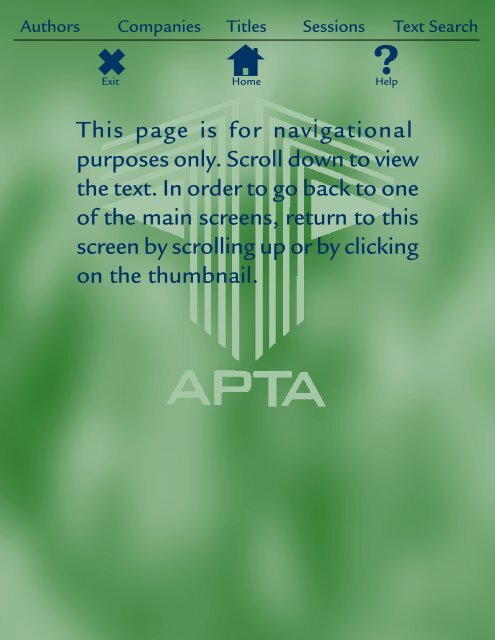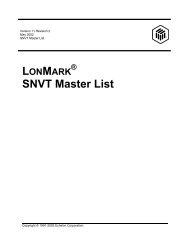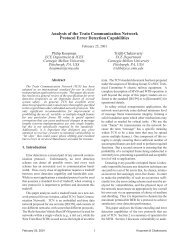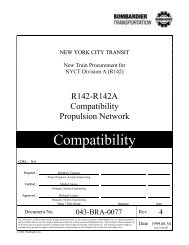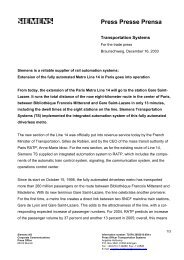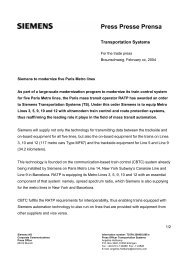Safety Certification Of MUNI'S Advanced Train Control ... - Tsd.org
Safety Certification Of MUNI'S Advanced Train Control ... - Tsd.org
Safety Certification Of MUNI'S Advanced Train Control ... - Tsd.org
Create successful ePaper yourself
Turn your PDF publications into a flip-book with our unique Google optimized e-Paper software.
Authors Companies Titles Sessions Text Search<br />
✖ Exit<br />
Home<br />
? Help<br />
This page is for navigational<br />
purposes only. Scroll down to view<br />
the text. In order to go back to one<br />
of the main screens, return to this<br />
screen by scrolling up or by clicking<br />
on the thumbnail.
ABSTRACT<br />
San Francisco’s Municipal Railway is currently in the<br />
throes of implementing our new <strong>Advanced</strong> <strong>Train</strong> <strong>Control</strong><br />
System (ATCS). Revenue Service implementation is<br />
proceeding in stages, each of increasing complexity.<br />
With ATCS, MUNI for the first time is opening a new rail<br />
extension under the safety oversight of the California Public<br />
Utilities Commission (CPUC). Each revenue stage must be<br />
independently safety certified. Project staff, working with<br />
our Engineering and <strong>Safety</strong> consultants, provide the<br />
necessary technical documentation for safety certification.<br />
In addition, the process requires all operating departments<br />
to participate in the process, with regard to procedures review<br />
and training. For some, this requires a significant change<br />
to their normal way of doing business. Since the<br />
safety certification process is basically a documentation<br />
activity, some operating departments need assistance in<br />
understanding the requirements, developing the Standard<br />
Operating Procedures (SOPs), and tracking all the activities<br />
necessary to meet the safety certification audit requirements.<br />
This paper will present how MUNI has defined and<br />
distilled the overall safety certification requirements into<br />
manageable deliverables for each area of responsibility; i.e.:<br />
track department; central control; vehicle maintenance, etc.<br />
The issues go beyond the bureaucratic and technical.<br />
Inevitably, there is also “culture shock” generated by any<br />
new system which is perceived to disrupt existing behaviors,<br />
as well as uneasiness created by MUNI’s first exposure to<br />
oversight by an outside agency.<br />
Solutions discussed will include: Convening a task force<br />
of all affected departments; tracking work via action items;<br />
defining specific deliverables; etc. This paper will present<br />
not only the “How to…”, but will also include some “How<br />
not to ….” advice, based on MUNI’s experience.<br />
INTRODUCTION<br />
<strong>Safety</strong> <strong>Certification</strong> <strong>Of</strong> MUNI’S <strong>Advanced</strong> <strong>Train</strong><br />
<strong>Control</strong> System: A View From The Trenches<br />
San Francisco Municipal Railway (MUNI) is the public<br />
transit agency for the City and County of San Francisco,<br />
supporting 700,000 passenger boardings daily, roughly equal<br />
Daniel J. Rosen and Patricia G. DeVlieg<br />
S.F. MUNI Railway<br />
San Francisco, CA<br />
1<br />
to the population of the City. MUNI operates four transit<br />
modes, the most celebrated being our cable cars, which are<br />
the last of their kind in the world. More conventional transit<br />
is provided by electric trolley, diesel bus, and streetcars.<br />
MUNI’s streetcar fleet has a historic component, with 17<br />
rehabilitated PCCs and 13 one-of-a-kind historic streetcars<br />
from around the world, which operate on our downtown<br />
surface feeder line. MUNI also provides light-rail service, in<br />
a mixed street and subway service into downtown.<br />
MUNI’s LRV (Light Rail Vehicle) fleet consists of 136<br />
light rail vehicles: 77 new Breda LRV2s are currently being<br />
delivered, supplemented by 59 Boeing SLRVs, which are<br />
now 20 years old. MUNI schedules approximately 900 LRV<br />
trips daily through the subway, and carries about 130,000<br />
passengers on 5 LRV lines. It is the safety certification of our<br />
recent major light-rail service expansion which is the subject<br />
of this paper.<br />
Projects Being Certified<br />
Since the opening of the Market Street Subway in 1980,<br />
MUNI’s LRV service has not expanded, other than a 3-mile Jline<br />
surface extension in 1993. All five surface LRV lines<br />
converge on the Market Street Subway, to serve five<br />
downtown stations, four of which are shared with BART<br />
(See Figure 1). All five lines turnback at Embarcadero Station.<br />
This stub-end turnback has long been identified as a<br />
significant throughput bottleneck, and plans for an expanded<br />
turnaround or turnback facility have been studied since the<br />
subway opened in 1980. Extensive redevelopment in the<br />
South-of-Market area (site of the new Giants’ Ballpark) in<br />
recent years, has stimulated the need for extending LRV<br />
service past Embarcadero Station. Another longstanding<br />
incentive has been to link MUNI rail service to the Cal<strong>Train</strong><br />
commuter rail operation which serves the Peninsula and<br />
South Bay.<br />
To address the need for improved subway service, and<br />
to serve the South-of-Market area, MUNI embarked on three<br />
major rail infrastructure upgrades:
• MUNI Metro Turnback (MMT): 0.5-mile extension<br />
from Embarcadero Station, including underground<br />
turnback and storage tracks, with a surface “Ferry<br />
Portal” on the Embarcadero at Folsom Street.<br />
• MUNI Metro Extension (MMX): 1.5 mile extension<br />
from the MMT’s Ferry Portal to the Cal<strong>Train</strong> Depot,<br />
including 4 surface stations.<br />
• <strong>Advanced</strong> <strong>Train</strong> <strong>Control</strong> System (ATCS): Replacement<br />
of the existing 100-Hz track-circuit based signal<br />
system with Communications Based <strong>Train</strong> <strong>Control</strong><br />
(CBTC), with the goals of enhancing throughput,<br />
safety, and operational flexibility.<br />
ATCS is being introduced into service in stages. ATCS<br />
Stage 1 introduced ATCS control in the MMT portion of the<br />
subway, with shuttle train service between Embarcadero<br />
Station and the Cal<strong>Train</strong> Depot.<br />
In October 1997, it was announced that revenue service<br />
would begin on January 10, 1998. Service on the MMX<br />
required implementing all three projects: ATCS to control<br />
the MMT; the MMT connection to the MMX; and the MMX<br />
surface extension. MUNI’s <strong>Safety</strong> <strong>Certification</strong> Plan (SCP)<br />
for ATCS Stage 1 was expanded to incorporate safety<br />
certification for the three projects.<br />
2<br />
MUNI’s Organizational Environment<br />
The San Francisco Municipal Railway (MUNI) inaugurated<br />
service in 1912, and is the oldest publicly owned<br />
Transit Company in the United States. From its roots as a<br />
traditional transit company, MUNI’s <strong>org</strong>anizational<br />
environment has changed radically. MUNI has undergone a<br />
number of <strong>org</strong>anizational restructurings. MUNI’s internal<br />
structure has been carved and recarved into various<br />
<strong>org</strong>anization styles: centralized versus decentralized; all<br />
authority at the Division or garage level, to authority at<br />
headquarters. These swings in <strong>org</strong>anizational styles have<br />
had a direct effect on MUNI’s <strong>Safety</strong> <strong>Certification</strong> in the<br />
following ways:<br />
• MUNI allowed a 4-member System <strong>Safety</strong> Department<br />
that was created in 1980 to diminish to a staff<br />
of 1. This has had the effect of minimizing the role<br />
System <strong>Safety</strong> was able to play in <strong>Safety</strong> <strong>Certification</strong>.<br />
• There has been no formal revision to the MUNI<br />
Rulebook (all modes: rail, bus, cable car, trolley)<br />
since 1971 and no formal change to the LRV Rules<br />
and Procedures in 20 years. The effect has been<br />
Figure 1. Area of Downtown Subway and the MMX Shuttle Service Extension
that no MUNI department has been charged with<br />
the responsibility of Rulebook revision.<br />
• MUNI does not yet have a unified maintenance<br />
training strategy in place, and the 3-year old<br />
maintenance training unit is chronically understaffed,<br />
with only three maintenance trainers for<br />
1000 maintenance employees. Therefore, individual<br />
maintenance units develop their own independent<br />
training strategies. This has meant that documentation<br />
of training has varied from unit to unit,<br />
and project to project.<br />
• Unlike most railroads, at MUNI there is no Rules<br />
Department.<br />
Culture Shock<br />
Even in the best of circumstances, implementing a major<br />
new system generates <strong>org</strong>anizational culture shock.<br />
Readying each of the three projects individually, while<br />
accepting a new LRV fleet, was already a major effort for<br />
MUNI. An added complication was the need to coordinate<br />
schedules and access to resources among the three projects<br />
so that completion converged on the same service-start/up<br />
date. The requirement to develop and implement a newly<br />
mandated <strong>Safety</strong> <strong>Certification</strong> Process added significantly<br />
to the overall complexity of the task, and had tremendous<br />
impacts on all aspects of rail operation.<br />
By its very nature, ATCS by itself has had a major impact<br />
on MUNI’s rail operations. ATCS moves the rail <strong>org</strong>anization<br />
from a decentralized control environment to a centralized<br />
one; from a loose-knit, informal training approach to a<br />
formalized well-documented training approach; from “okhe’s-ready-to-go”<br />
to a formal certification of each individual;<br />
from “what do you mean there are no track circuits and no<br />
shunt protection for signal crews” to a maintenance<br />
environment governed by strict supervision from Central<br />
<strong>Control</strong> to grant subway access to signal maintenance crews.<br />
Another culture shock has been the introduction of<br />
oversight by the California State Public Utilities Commission<br />
(CPUC). MUNI inaugurated service in 1912 as a self-certifying<br />
railway. Subsequently, the California State PUC was formed,<br />
and MUNI’s rail operation was explicitly “grandfathered”<br />
out of CPUC oversight. Recent Federal legislation required<br />
that MUNI’s rail operations come under CPUC safety<br />
oversight on January 1, 1996. The ATCS/MMT/MMX<br />
extension which commenced service on January 10, 1998<br />
was the first major MUNI rail service extension subject to<br />
CPUC oversight.<br />
3<br />
ATCS INDEPENDENT SAFETY REVIEW<br />
Prior to MUNI’s rail operations coming under CPUC<br />
oversight, the ATCS Contract had provided for contracting<br />
with an Independent <strong>Safety</strong> Consultant (ISC) to oversee the<br />
implementation of all safety-critical elements of ATCS. MUNI<br />
contracted with Lea + Elliott to serve as the ISC for MUNI’s<br />
ATCS. The ISC was contracted to provide an independent<br />
safety audit of both hardware and software modifications to<br />
the standard Alcatel SELTRAC product required for MUNI’s<br />
installation. The ISC’s mandate includes:<br />
• To Develop an ATCS-specific System <strong>Safety</strong><br />
Program Plan (SSPP), including a problem identification<br />
and tracking methodology for safety<br />
issues, to ensure that all safety-related items are<br />
successfully tracked, and the proper resolution<br />
identified and documented;<br />
• To Chair a <strong>Safety</strong> Advisory Board (SAB) to identify,<br />
examine and resolve safety-related issues that arise<br />
throughout the course of the ATCS procurement;<br />
• To Review safety critical Alcatel submittals; also<br />
the role of humans (passengers and MUNI<br />
personnel) relative to their potential impact upon<br />
the overall safety of the ATCS, including operating<br />
procedures, maintenance and training programs<br />
and their relationship to ATCS safety;<br />
• To Qualitatively Analyze Software of the ATCS<br />
supplier;<br />
• To Monitor and Evaluate safety-related activities<br />
and inputs of the ATCS supplier throughout the<br />
procurement process, including ATCS design<br />
reviews;<br />
• To Audit safety verification safety analyses, test<br />
results, records of prior experiences submitted by<br />
Alcatel, and observe and review at-plant and onsite<br />
tests and demonstrations of ATCS.<br />
<strong>Safety</strong> Advisory Board (SAB)<br />
A primary task of the ISC has been to chair the ATCS<br />
<strong>Safety</strong> Advisory Board (SAB). The SAB is a team of<br />
individuals representing the diverse elements of the MUNI,<br />
as well as the outside expertise (consultants) employed to<br />
facilitate or oversee implementation of the ATCS. Representatives<br />
on the SAB include MUNI System <strong>Safety</strong>,<br />
Maintenance, Operations, ATCS Project staff, Booz-Allen<br />
& Hamilton (ATCS Engineering Consultant) and Lea + Elliott<br />
(ATCS Independent <strong>Safety</strong> Consultant.). Others in<br />
attendance at SAB meetings are representatives from the
CPUC and the FTA Project Management Oversight (PMO)<br />
team, as well as representatives from Alcatel (the ATCS<br />
Contractor).<br />
The SAB meets at regular intervals, and tracks safetyrelated<br />
open items. The Board has the authority to assign<br />
tasks to Board members to resolve open safety items.<br />
Typically, these activities include, investigating specific<br />
ATCS design elements; documenting and recommending<br />
adjustments to MUNI’s operations and maintenance<br />
practice; integrating safety elements of ATCS with adjacent<br />
systems, especially LRV2. In some cases the Board has<br />
directed MUNI to conduct specific tests to provide field<br />
evidence of ATCS or vehicle characteristics.<br />
In the event of any safety-related incidents occurring in<br />
the course of the ATCS project, the SAB takes the lead role<br />
in evaluating the findings of the subsequent investigation,<br />
and the merit of any proposed mitigations.<br />
OVERVIEW OF SCP (SAFETY<br />
CERTIFICATION PLAN)<br />
MUNI’s <strong>Safety</strong> <strong>Certification</strong> process provided for<br />
certification of three Capital Projects: ATCS-Stage 1, the<br />
MMT Subway extension and turnback facility, and the MMX<br />
surface extension. Both the MMT and MMX rail extensions<br />
Identify<br />
the<br />
Certifiable<br />
Elements<br />
Identify<br />
<strong>Safety</strong><br />
Requirements<br />
Review<br />
Compliance<br />
Document<br />
Process<br />
ATCS<br />
Contract<br />
Specificaon<br />
Develop<br />
Specification<br />
Conformance<br />
Checklist<br />
Review<br />
Compliance<br />
with<br />
Specification<br />
Conformance<br />
Checklist<br />
EXHIBIT 2-1<br />
Stage 1 ATCS <strong>Safety</strong> <strong>Certification</strong> Process<br />
Maintenance<br />
Plan<br />
Operating<br />
Procedures<br />
&<br />
Rulebook<br />
Review Updated Plans,<br />
Rulebook, and Procedures<br />
Against Independent <strong>Safety</strong><br />
Consultant OHA Requirements<br />
Issue Certificates of Compliance<br />
4<br />
were near completion prior to the commencement of CPUC<br />
oversight. In meetings with the CPUC, it was determined<br />
that the design, engineering and construction practices<br />
already in place on MMT and MMX would satisfy CPUC<br />
requirements. However, certification for training, and rules<br />
and procedures for all three projects, as well as ATCS safety<br />
verification and validation certification, would be required<br />
in the SCP.<br />
Requiring that three projects be certified meant that<br />
elements from each were rolled into one unified <strong>Safety</strong><br />
<strong>Certification</strong> Plan. The SCP that had been developed by the<br />
ATCS Consultant, BAH, dealt exclusively with the ATCS<br />
Stage 1 <strong>Safety</strong> <strong>Certification</strong> requirements. Therefore when<br />
the decision was made to combine certification for the three<br />
projects into one, the SCP was expanded to include elements<br />
from the other projects.<br />
Additional elements from the MMT and MMX projects<br />
that were incorporated into the existing SCP for ATCS<br />
included: Ventilation and Undertrain Deluge training (MMT),<br />
SF Fire Department (SFFD) orientation and familiarization<br />
training (MMT), Central <strong>Control</strong> Emergency procedures<br />
(MMT & ATCS), rules and procedures revision (MMT/<br />
MMX/ATCS). Operations and maintenance training elements<br />
were expanded to include all three projects. <strong>Train</strong> operators<br />
had to become familiar with new territory, (the MMT, and<br />
<strong>Train</strong>ing<br />
Programs<br />
Prepare Operating and Support Hazard Analysis of<br />
MUNI ATCS<br />
(Completed by Independent <strong>Safety</strong> Consultant)<br />
Complete<br />
Maintenance<br />
and Operator<br />
<strong>Train</strong>ing<br />
Independent<br />
<strong>Safety</strong><br />
Consultant<br />
Submit<br />
Independent<br />
<strong>Safety</strong><br />
Report<br />
Figure 2. Stage 1 ATCS <strong>Safety</strong> <strong>Certification</strong> Process<br />
ATCS<br />
Contractor<br />
Submit<br />
Contractor<br />
Letter of<br />
<strong>Safety</strong><br />
<strong>Certification</strong>
MMX) as well as ATCS. Maintenance staff were trained on<br />
components of ATCS, MMT switches and facility systems,<br />
as well as the surface Vital Processor Interlockings (VPI) and<br />
track signals and switches (MMX). Documentation for all of<br />
these activities had to be included as part of the SCP.<br />
The guiding document for this effort was a <strong>Safety</strong><br />
certification Plan (SCP) drafted by Booz-Allen & Hamilton<br />
and adopted by MUNI. Figure 2 provides an overview of the<br />
SCP process. The work of the SCP is distilled into the list of<br />
Certifiable Elements and Deliverables, which make up the<br />
final report, and are listed below:<br />
SCP Certifiable Elements<br />
1. ATCS Contract, by the ATCS Engineering<br />
Consultant (BAH)<br />
2. Central <strong>Control</strong> Operating Manual, by MUNI and<br />
BAH<br />
3. LRV Operating Rules and Procedures, by MUNI<br />
4. Central <strong>Control</strong> Operator <strong>Train</strong>ing Program, by<br />
Contractors and MUNI<br />
5. Vehicle Operator <strong>Train</strong>ing Program, by MUNI<br />
6. Rail Inspectors <strong>Train</strong>ing Program, by MUNI<br />
7. Independent <strong>Safety</strong> Consultant (ISC) Review, by<br />
ATCS ISC (L+E)<br />
8. MUNI Maintenance Plan, by Contractors and<br />
MUNI<br />
9. <strong>Safety</strong> Advisory Board Open Items, by ATCS ISC<br />
(L+E)<br />
SCP Deliverables<br />
1. Certificates of Compliance for each Certifiable<br />
Element<br />
2. Procedure Review Checklists<br />
3. Specification Conformance Checklist<br />
4. Operations and Maintenance <strong>Train</strong>ing Records<br />
5. Report of the Independent <strong>Safety</strong> Consultant<br />
6. Contractor’s Statement of <strong>Safety</strong> <strong>Certification</strong><br />
TEN ELEMENTS FOR SUCCESS<br />
By following the SCP, MUNI was able to meet all the<br />
requirements and begin Revenue Service on the January 10,<br />
1998 start date. Listed below are lessons learned from<br />
MUNI’s experience:<br />
1. Skills Needed On the Team To Be Successful<br />
What skills do you need on your team to successfully<br />
complete the SCP?<br />
5<br />
OVERVIEW person from the Transit Property who<br />
understands the SCP process, who can liaison with<br />
consultant and professional <strong>Safety</strong> Experts. If possible, this<br />
person should also be able to put the SCP in terms your<br />
people will understand, i.e. someone who can talk with the<br />
Track Foreman and explain what the SCP is.<br />
ORGANIZER person who is systematic and <strong>org</strong>anized,<br />
a great filer, a detail person, a person who loves to make<br />
checklists to see that all tasks are carried out.<br />
MICRO MANAGER who can insure all the tasks are<br />
being done. Since this is a far-flung effort involving many<br />
different departments, consultants, and other agencies, it<br />
needs pretty tight rein. This person also must be able to<br />
diplomatically remind people who may have not followed<br />
through on assigned tasks.<br />
CLERICAL person who is self-directed, <strong>org</strong>anized and<br />
systematic to collate, copy and assemble the final document.<br />
Our SCP was two volumes.<br />
2. Department Buy-In—Outreach Into the<br />
Organization<br />
We recommend getting affected departments involved<br />
as early as possible. Our SCP started late in the game because<br />
there was trouble fixing a service start-up date. Mid-level<br />
managers, supervisors, and foremen should be given a<br />
working knowledge of what the SCP is. Over and above<br />
formal training, circulating Frequently Asked Questions<br />
(FAQs) was favorably received by staff at all levels (see<br />
Figure 3).<br />
3. Letting Staff Know What Their Responsibilities<br />
Are In The SCP Process<br />
We formed a Start-up Technical Advisory Committee<br />
(TAC), with project staff from ATCS, MMT and MMX, as<br />
well as MUNI line managers, to coordinate the start-up<br />
activities. The SCP was identified as an ATCS Project team<br />
task item that was tracked by the Start-up TAC. The TAC<br />
forum was used to educate MUNI’s line managers on their<br />
responsibilities under the SCP. This forum helped change<br />
their perception that this was something being done to them,<br />
to an understanding that this was a collaborative effort.<br />
Responsibilities of line managers included: to review rules<br />
and procedures; to document training sessions; to develop<br />
and approve lesson plans; to keep detailed files, and the<br />
like. A word to the wise: When your SCP is complete,<br />
disseminate copies of the final report to TAC members, with<br />
a “Thank You” for a job well done. (Thirty copies of the twovolume<br />
final report were distributed throughout MUNI.)
FREQUENTLY ASKED QUESTIONS ON MMX SHUTTLE SERVICE, Number 3<br />
Q: What are the expected benefits of<br />
ATCS?<br />
Answerman: When ATCS is fully<br />
functional, it will allow MUNI to operate<br />
more trains per hour in the subway.<br />
(“increased throughput” for your buzzword<br />
collection). This will put an END TO<br />
SCHEDULED COUPLING at the portals!<br />
ATCS trains will travel at the maximum<br />
authorized speed through the subway<br />
automatically, reducing travel time for<br />
passengers. Turnback time will be<br />
reduced from today’s 3 minutes to a<br />
matter of seconds. There are many other<br />
benefits:<br />
- increased safety<br />
- centralized system overview & control<br />
- data logging on vehicles & wayside<br />
- new signal equipment, replacing old<br />
stuff<br />
- new automated passenger<br />
announcements, on vehicles & at<br />
stations<br />
Q: Why do LRV2s have an IATP<br />
system?<br />
Answerman: MUNI extended the ATCS<br />
schedule to allow for an important<br />
upgrade of the ATCS computer systems.<br />
Without the upgrade, we would have been<br />
stuck with old time minicomputers at<br />
Central <strong>Control</strong>, which were “proven in<br />
service” as required, but very outdated.<br />
This schedule change meant that LRV2s<br />
would arrive before ATCS was ready, and<br />
could not run in the subway. What to do?<br />
To allow LRV2s to run with the existing<br />
signal system, Alcatel designed an Interim<br />
Figure 3<br />
6<br />
Automatic <strong>Train</strong> Protection (IATP) system.<br />
IATP uses the ATCS Vehicle On-Board<br />
Computer (VOBC) and temporary cabsignal<br />
antennas to pickup and decode the<br />
3 speed codes we are familiar with. Once<br />
the ATCS is fully operational in the<br />
subway, IATP will be removed.<br />
Q: Why does it take so long to test the<br />
ATCS?<br />
Answerman: Who remembers how long<br />
it took to debug and test our existing<br />
(simple!) cab-signal system during Metro<br />
startup? Now we are commissioning a<br />
more complex system, and have only<br />
nights available for testing. And<br />
debugging software is never easy,<br />
especially when it must be proven safe.<br />
Remember, even Windows ’95 was late<br />
and it crashes at any speed!<br />
Q: We hear rumors that the ATCS<br />
Project is 10 years late and costs $100<br />
million dollars. What is the truth?<br />
Answerman: The project started in<br />
August 1992, for completion in August<br />
1995; project budget $68M = $52M<br />
Alcatel + $16M (sales tax + support +<br />
contingency). When MUNI agreed to<br />
upgrade to the new central computers<br />
(see IATP question above), the contract<br />
schedule was extended to 1997. There<br />
were more problems, and more MUNIinitiated<br />
change orders, and we extended<br />
the schedule again; currently the project<br />
budget stands at $80M: ($50.8 Alcatel +<br />
$29.2M support). Alcatel’s cut actually<br />
went down, due to a reduction in fleet<br />
size. We are late, but are targeting<br />
project completion by the end of 1998.
4. SCP Milestones<br />
We recommend defining a way to measure progress as<br />
it occurs throughout development of the SCP<br />
documentation. This was another shortcoming in our<br />
process. Since we started late, we were on a very tight<br />
schedule, so the final report seemed to appear out of<br />
nowhere. A better approach would be to determine<br />
intermediate milestones and acknowledge each interim<br />
accomplishment. Set a target date for SCP completion well in<br />
advance of revenue service start up. MUNI did not have<br />
that luxury and the final report was hand-carried to the CPUC<br />
a day before revenue service began.<br />
5. Don’t Lose Sight of Important Things<br />
“Don’t miss the tree for the forest.” The SCP process<br />
requires a significant effort. After you say “Yes everything<br />
is covered in the SCP.”, ask yourself, “Are the top 10 rules<br />
and procedures that affect day-to-day operation covered?”<br />
Identify the real emergency situations that are most likely to<br />
occur. Review how all new staff are prepared. (Do they have<br />
the materials, handouts, manuals on hand?). Spot checks<br />
can help with this effort. Since MUNI was new at this, our<br />
focus was too much on satisfying the oversight agency and<br />
making sure we had a complete package.<br />
6. System <strong>Safety</strong>’s Role<br />
Use the System <strong>Safety</strong> unit to perform an audit function.<br />
Do this before start up if you have the time, but for sure,<br />
immediately after startup once things settle down. The auditor<br />
should check how field staff respond to:<br />
EMERGENCY OPERATING PROCEDURES: (If Central<br />
<strong>Control</strong> asked you to activate the Emergency Fans, how you<br />
would do it?)<br />
ABNORMAL SITUATIONS: (What do you have to do<br />
to insure safe movement of trains through this failed<br />
switch?).<br />
We did not do such an audit, and had a couple of small<br />
incidents and minor accidents. They occurred in spite of the<br />
fact that the SCP documented the rules and procedures<br />
necessary for safe operation.<br />
7. Identify Critical Rules and Procedures<br />
This is an outgrowth of the shortcomings of number 5<br />
and number 6. As part of the next ATCS Staged Release, a<br />
rules and procedures review committee was formed.<br />
Operations, <strong>Train</strong>ing, Central <strong>Control</strong>, the Rail Division<br />
Superintendent and Maintenance Representative comprise<br />
the committee, whose task is to provide the top 10 incidents<br />
7<br />
for which adherence to rules and procedures is critical for<br />
safe operation. These will be reissued in a special guide,<br />
checklist, etc. and emphasized in all training given prior to<br />
the start of revenue service.<br />
8. Ongoing Documentation<br />
This is “motherhood and apple pie”, but it cannot be<br />
over emphasized. Provide standard “templates” for<br />
documentation activities, to simplify the task and provide<br />
for a consistent documentation packet as the final SCP<br />
deliverable. Two areas where templates may be especially<br />
useful are review of rules and procedures and training<br />
documentation.<br />
9. <strong>Safety</strong> Advisory Board and Independent <strong>Safety</strong><br />
Consultant (ISC)<br />
Using an Independent <strong>Safety</strong> Consultant for safety<br />
oversight on a project is new to MUNI with the ATCS project,<br />
and has proven to be a very successful innovation. The ISC<br />
has been invaluable in grounding ATCS safety assurance<br />
by providing professional and objective guidance. The<br />
ATCS ISC has been well received within MUNI, and it is<br />
expected that future projects with significant safety-critical<br />
elements will adopt the same strategy of bringing an ISC onboard.<br />
10. Software <strong>Safety</strong> Verification & Validation<br />
MUNI’s business is delivering transit service, not<br />
software development. Rather than maintaining software<br />
development expertise in-house, MUNI has been well-served<br />
by including software safety verification & validation (V&V)<br />
in the ISC’s scope of work. This effort has included<br />
maintaining the following documentation:<br />
• <strong>Safety</strong> V&V Matrix: Incorporated into Alcatel’s V&V<br />
Process Report (a required submittal), the V&V<br />
Matrix lists all ATCS safety requirements, their<br />
respective mitigations, and the means by which<br />
each is verified. Verification is by analysis and/or<br />
test. Tests include unit tests, engineering integration<br />
tests, system integration tests and/or field<br />
commissioning tests.<br />
• O&SHA (Operating & Support Hazard Analysis):<br />
This analysis lists potentially hazardous operations,<br />
maintenance and test activities which are procedurally<br />
dependent. These are derived from the<br />
ATCS Technical Specification itself, design reviews,<br />
plan and program reviews, safety analyses, and<br />
tests results. Associated hazards are characterized
according to severity, probability and required<br />
mitigation. Verification is generally through design<br />
review, procedures review, and test and/or<br />
demonstration.<br />
• Test Monitoring Plan: All tests required for<br />
commissioning the ATCS were tracked in this<br />
database. Tests to verify safety requirements or<br />
O&SHA mitigations were cross referenced. Test<br />
procedure status, including all submittals, reviews,<br />
re-submittals and approvals, was maintained and<br />
continuously updated.<br />
• <strong>Safety</strong> <strong>Certification</strong> Specification Conformance<br />
Checklist (by BAH): <strong>Safety</strong> requirements were<br />
extracted from the Contract Technical Specifications<br />
and entered into a checklist. Each requirement was<br />
then matched with associated evidence of<br />
verification that the requirement was met, through<br />
design review, Alcatel submittal, analysis and/or<br />
test.<br />
CONCLUSION<br />
MUNI successfully completed the <strong>Safety</strong> <strong>Certification</strong><br />
Process and inaugurated a new revenue service requiring<br />
the integration of three large capital projects. In doing so,<br />
MUNI demonstrated that with proper staff, technical support<br />
from consultants, an <strong>org</strong>anized approach, and a working<br />
knowledge of the SCP, success is achievable in any transit<br />
environment.<br />
8<br />
The lessons learned which are key to success are<br />
summarized below:<br />
1. Allow sufficient time;<br />
2. Involve staff in the process as soon as possible;<br />
3. Prepare and follow a detailed plan;<br />
4. Make tasks for line-staff specific, easy to understand,<br />
and easy to document;<br />
5. Get clear expectation from oversight agency as to<br />
what they require;<br />
6. Document relevant activities consistently and at<br />
the time they occur.<br />
ACKNOWLEDGMENTS<br />
Any opinions, omissions or errors contained herein are<br />
the sole responsibility of the authors. The authors also wish<br />
to thank the following individuals, who contributed greatly<br />
to the success of ATCS Stage 1 <strong>Safety</strong> <strong>Certification</strong>: Tom<br />
Griego (BAH), Charlie Martin (L+E), Cindy Sugimoto (L+E),<br />
Steve Beebe (Virginkar & Assoc), Jim Elliston (Cornerstone<br />
Consilium), Joery Nacion (MUNI).
TABLE 1<br />
MUNI ACRONYMS AND ABBREVIATIONS<br />
ATCS <strong>Advanced</strong> <strong>Train</strong> <strong>Control</strong> System<br />
BAH Booz-Allen & Hamilton (ATCS & LRV2 Engineering Consultant)<br />
BART Bay Area Rapid Transit<br />
CBTC Communications Based <strong>Train</strong> <strong>Control</strong><br />
CPUC California Public Utilities Commission<br />
FAQ Frequently Asked Questions<br />
FTA Federal Transportation Administration<br />
L+E Lea+Elliott (ATCS Independent <strong>Safety</strong> Consultant)<br />
LRV Light Rail Vehicle<br />
LRV2 MUNI’s second Light Rail Vehicle (built by Breda)<br />
MMT MUNI Metro Turnback (new subway extension, turnback tracks, & surface portal)<br />
MMX MUNI Metro Extension (new surface extension, with 4 surface platforms)<br />
MUNI San Francisco Municipal Railway<br />
OJT On-the-Job <strong>Train</strong>ing<br />
O&SHA Operating and Support Hazard Analysis<br />
PCC Presidential Conference Car<br />
PMO Project Management Oversight<br />
SAB <strong>Safety</strong> Advisory Board (for ATCS)<br />
SCP <strong>Safety</strong> <strong>Certification</strong> Plan<br />
SFFD San Francisco Fire Department<br />
SLRV Standard Light Rail Vehicle (built by Boeing-Vertol)<br />
SSPP System <strong>Safety</strong> Program Plan<br />
TAC Technical Advisory Committee (MUNI’s start-up task force)<br />
VPI Vital Processor Interlocking (surface interlocking control, for MMX)<br />
V&V Verification & Validation<br />
9


